Have you seen the term "DNA Overlap" on your 23andMe DNA match list? In this post, where to find this information, and what it means about your relationship with your DNA relatives.
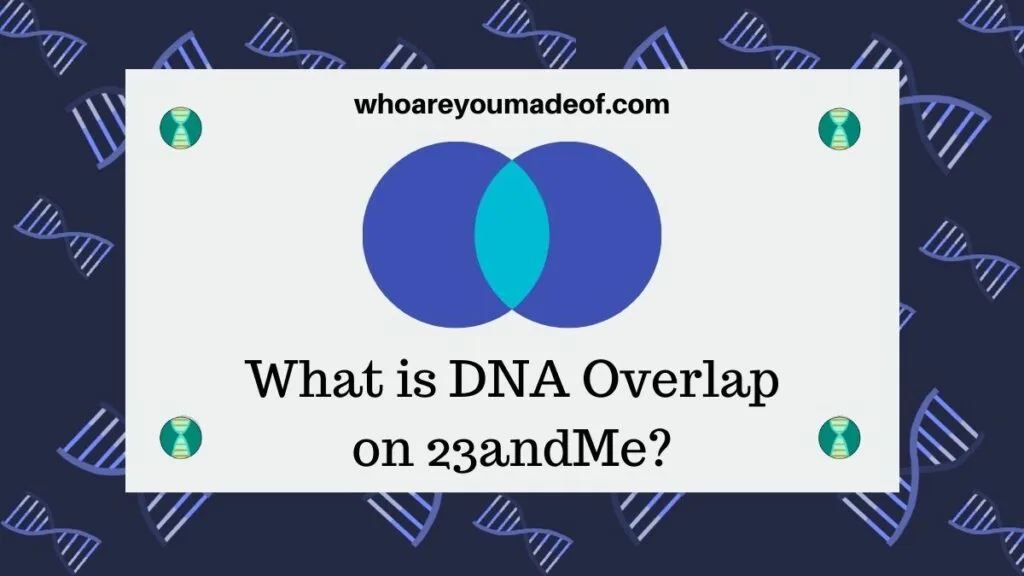
I love 23andMe for many reasons, but one of the top reasons is because they let us see so much information about our genetic connection with our DNA matches, which are called "DNA Relatives" on the site.
For the purpose of this article, I will use the term DNA match and DNA relative interchangeably, since they are the same.
For example, we can use the chromosome browser to see exactly where the DNA segments that we share with our relatives are on our chromosomes. One other very helpful bit of information that we can access is whether or not our DNA match and relatives that we share in common on 23andMe have "overlap".
Where to find where there is overlap on 23andMe?
You can find information about DNA Overlap once you have chosen a DNA Relative, or DNA match, to examine from your DNA match list. Once you are viewing the DNA match profile, scroll down towards the bottom of the page and click on the blue button that says "Find Relatives in Common".
A list should load that says "You have Relatives in Common" at the top. This is a list of DNA matches that you and your DNA match share in common.
You will see a few different columns of information, but since we are here to focus on DNA Overlap, let's skip to the last column. In the image below, I have highlighted this column in red so you know exactly where to look.
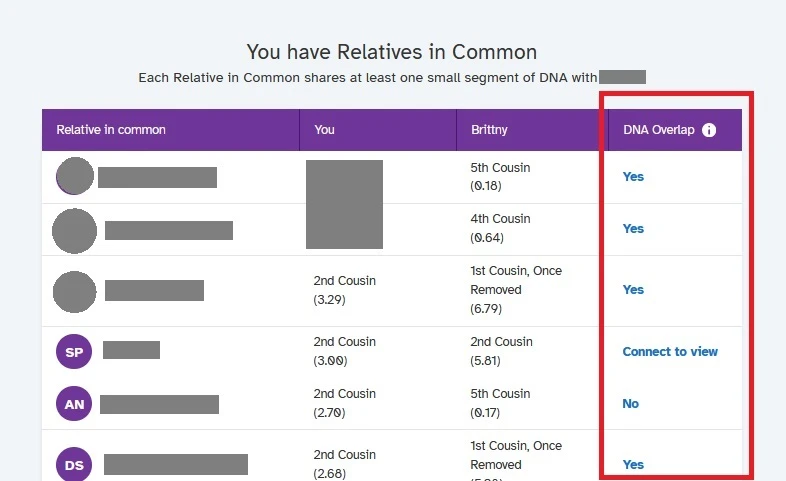
There are three different results that you might see in the DNA Overlap column. Yes, No, and Connect to View are the only options that currently display here, and below I'll go into detail as to the meaning and ramifications of having (or not having) overlap with these shared DNA matches.
What does "Yes" mean on DNA overlap?
If the DNA Overlap column says "Yes", then it means that you, the DNA match that you are viewing, and the DNA match in that row all share at least one overlapping segment of DNA at the same location on the same chromosome.
Many times, especially with closer relatives, this indicates that you, your DNA match, and the match that you share in common all inherited this overlapping DNA from the same common ancestor.
Take, for example, "DS" from the image below from my mother's DNA match "Greta". My mother and Greta share "DS" in common as a match, and there is DNA Overlap.
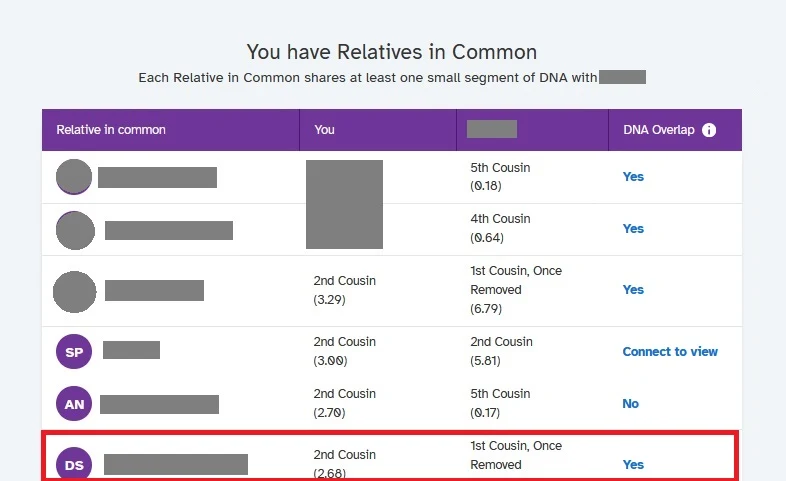
It is possible that my mom, Greta, and DS, inherited an overlapping DNA segment from an ancestor that all three of them share in common. My mom is a second cousin to both Greta and DS, and Greta is a 1st cousin once-removed to DS.
Does having DNA overlap mean you are all descended from the same ancestor?
The most common reason that you will show DNA Overlap on 23andMe is because all three of you (i.e. you, your match, and the relative that you share in common) are all descended from the same person and all three of you have the same DNA segment(s) inherited from that ancestor.
However, it is important to know that you and your DNA match, or you and the match you share in common, might have DNA segments in common that don't overlap with the third person. This is because you might have inherited some DNA segments from the ancestor you share in common that the other person didn't inherit.
This is most common when one of the DNA matches is more distantly related than the other two. For example, two first cousins will share many DNA segments that overlap, some that don't, and then will likely share fewer overlapping segments with a third cousin they share in common.
What does no mean on DNA overlap?
You will often find that there is no DNA Overlap with matches that you share in common with a DNA relative. This only means that you, your DNA match, and the person who you share in common, have DNA segments that match each other, but not all at the same location in your chromosome.
In the image below, you can see that my mother, Greta, and "AN" all show up as DNA matches for each other. However, there is no DNA Overlap, which means that while all three of these individuals share DNA, it is not identical on the same DNA segments.
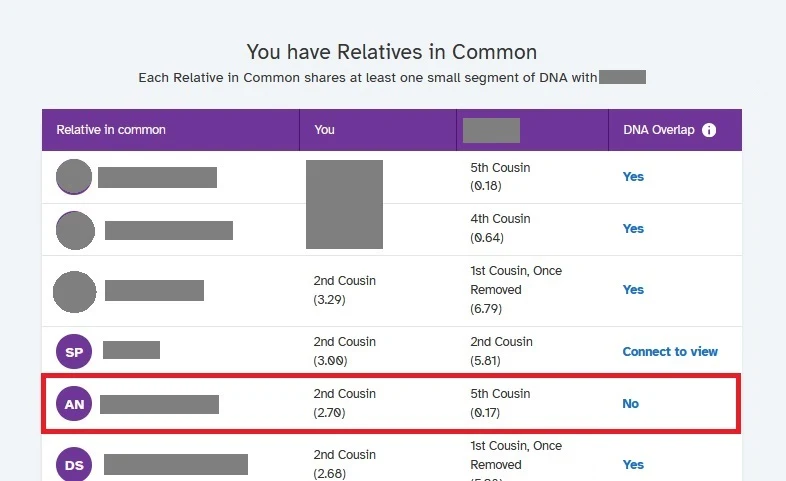
This is an interesting case because we know that Greta and my mom are second cousins, and we can see that my mom and AN are also second cousins. However, Greta is estimated to be related to AN at a 5th cousin distance.
This is significant, and I will explain why below.
Does having no DNA overlap mean you are not really all related?
Having no DNA Overlap with you, a match, and a relative you share in common could mean that you are all not related through the same common ancestor. You are likely still related to both of these individuals, just like your DNA match is also likely related to you and this third person, but you all could be related in different ways.
You can have no DNA overlap and still be related through the same ancestor
Alternatively, you could all be related to each other through the same common ancestor, even if you have No DNA Overlap. In this case, you all inherited DNA from that common ancestor, which is why you show up as DNA matches for each other.
However, a lack of DNA Overlap in this situation simply means that while all three of you did inherit DNA from the same ancestor, you didn't inherit the same DNA segments from them. This is very normal, and occurs more often in distant relatives.
As you noticed from our example with my mom, Greta, and AN, we see that AN is estimated to be distantly related to Greta (5th cousin). One possibility is that all three are descended from the same person, but AN is more distantly descended from the common ancestor.
This would mean that AN inherited less DNA overall from the common ancestor and is thus less likely to have a segment that is shared in common with both my mom and Greta.
What does connect to view mean on DNA overlap?
"Connect to view" simply means that the DNA relative that you and your DNA match share in common has their privacy settings set to only show details like DNA Overlap to people who they have connected with individually.
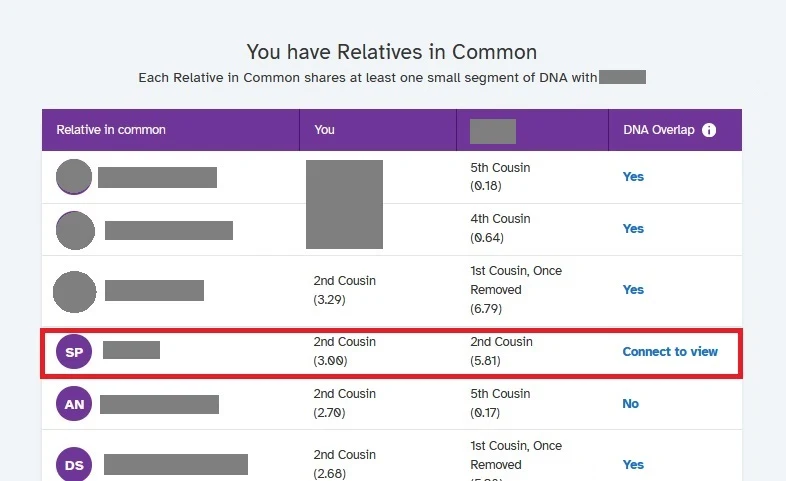
The DNA match above that my mom shares in common with Greta ("SP") has set their privacy settings to where my mom would have to request to connect with SP. SP would then authorize the connection, and then my mother would be able to see whether Greta and SP share overlapping segments with her, as well as other details about their genetic connection.
Conclusion
I hope that this post has helped you understand exactly what overlap means on your 23andMe results, and how it can help you understand how you might, and might not, be related to your groups of DNA matches.
As always, if you have any questions about something that you read here, or if you would like to share a specific question about an overlap situation that you see on your results, please feel free to join in the discussion below.
Thanks for stopping by today!
